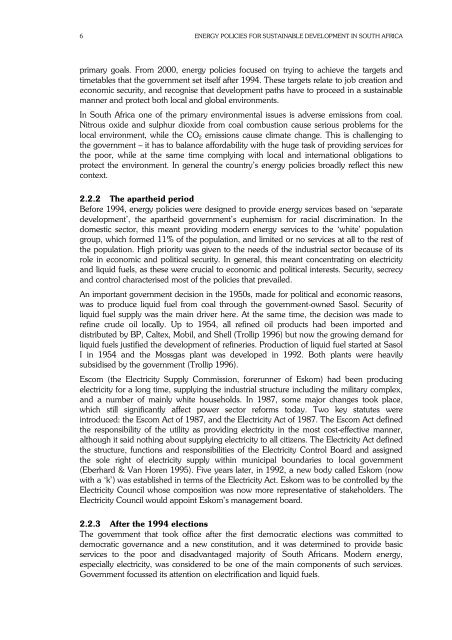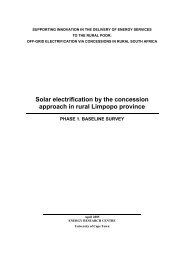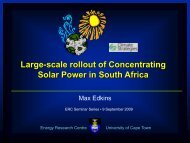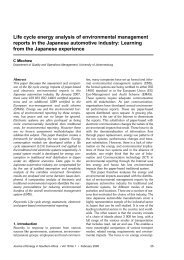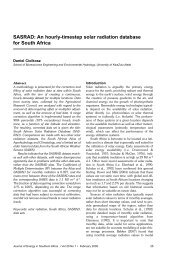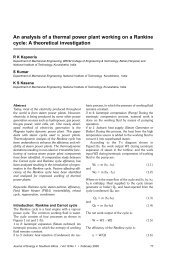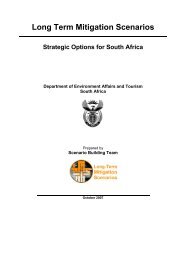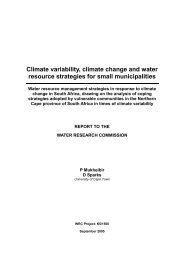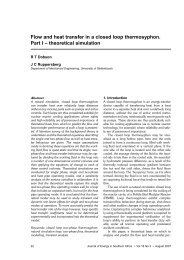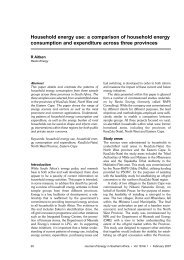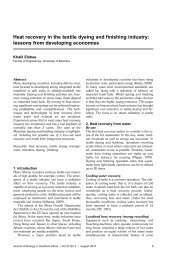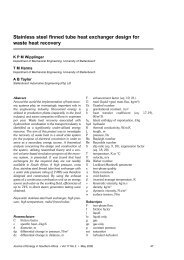(Ed) 2006. Energy policies for sustainable development in South Africa
(Ed) 2006. Energy policies for sustainable development in South Africa
(Ed) 2006. Energy policies for sustainable development in South Africa
You also want an ePaper? Increase the reach of your titles
YUMPU automatically turns print PDFs into web optimized ePapers that Google loves.
6 ENERGY POLICIES FOR SUSTAINABLE DEVELOPMENT IN SOUTH AFRICA<br />
primary goals. From 2000, energy <strong>policies</strong> focused on try<strong>in</strong>g to achieve the targets and<br />
timetables that the government set itself after 1994. These targets relate to job creation and<br />
economic security, and recognise that <strong>development</strong> paths have to proceed <strong>in</strong> a <strong>susta<strong>in</strong>able</strong><br />
manner and protect both local and global environments.<br />
In <strong>South</strong> <strong>Africa</strong> one of the primary environmental issues is adverse emissions from coal.<br />
Nitrous oxide and sulphur dioxide from coal combustion cause serious problems <strong>for</strong> the<br />
local environment, while the CO 2 emissions cause climate change. This is challeng<strong>in</strong>g to<br />
the government – it has to balance af<strong>for</strong>dability with the huge task of provid<strong>in</strong>g services <strong>for</strong><br />
the poor, while at the same time comply<strong>in</strong>g with local and <strong>in</strong>ternational obligations to<br />
protect the environment. In general the country’s energy <strong>policies</strong> broadly reflect this new<br />
context.<br />
2.2.2 The apartheid period<br />
Be<strong>for</strong>e 1994, energy <strong>policies</strong> were designed to provide energy services based on ‘separate<br />
<strong>development</strong>’, the apartheid government’s euphemism <strong>for</strong> racial discrim<strong>in</strong>ation. In the<br />
domestic sector, this meant provid<strong>in</strong>g modern energy services to the ‘white’ population<br />
group, which <strong>for</strong>med 11% of the population, and limited or no services at all to the rest of<br />
the population. High priority was given to the needs of the <strong>in</strong>dustrial sector because of its<br />
role <strong>in</strong> economic and political security. In general, this meant concentrat<strong>in</strong>g on electricity<br />
and liquid fuels, as these were crucial to economic and political <strong>in</strong>terests. Security, secrecy<br />
and control characterised most of the <strong>policies</strong> that prevailed.<br />
An important government decision <strong>in</strong> the 1950s, made <strong>for</strong> political and economic reasons,<br />
was to produce liquid fuel from coal through the government-owned Sasol. Security of<br />
liquid fuel supply was the ma<strong>in</strong> driver here. At the same time, the decision was made to<br />
ref<strong>in</strong>e crude oil locally. Up to 1954, all ref<strong>in</strong>ed oil products had been imported and<br />
distributed by BP, Caltex, Mobil, and Shell (Trollip 1996) but now the grow<strong>in</strong>g demand <strong>for</strong><br />
liquid fuels justified the <strong>development</strong> of ref<strong>in</strong>eries. Production of liquid fuel started at Sasol<br />
I <strong>in</strong> 1954 and the Mossgas plant was developed <strong>in</strong> 1992. Both plants were heavily<br />
subsidised by the government (Trollip 1996).<br />
Escom (the Electricity Supply Commission, <strong>for</strong>erunner of Eskom) had been produc<strong>in</strong>g<br />
electricity <strong>for</strong> a long time, supply<strong>in</strong>g the <strong>in</strong>dustrial structure <strong>in</strong>clud<strong>in</strong>g the military complex,<br />
and a number of ma<strong>in</strong>ly white households. In 1987, some major changes took place,<br />
which still significantly affect power sector re<strong>for</strong>ms today. Two key statutes were<br />
<strong>in</strong>troduced: the Escom Act of 1987, and the Electricity Act of 1987. The Escom Act def<strong>in</strong>ed<br />
the responsibility of the utility as provid<strong>in</strong>g electricity <strong>in</strong> the most cost-effective manner,<br />
although it said noth<strong>in</strong>g about supply<strong>in</strong>g electricity to all citizens. The Electricity Act def<strong>in</strong>ed<br />
the structure, functions and responsibilities of the Electricity Control Board and assigned<br />
the sole right of electricity supply with<strong>in</strong> municipal boundaries to local government<br />
(Eberhard & Van Horen 1995). Five years later, <strong>in</strong> 1992, a new body called Eskom (now<br />
with a ‘k’) was established <strong>in</strong> terms of the Electricity Act. Eskom was to be controlled by the<br />
Electricity Council whose composition was now more representative of stakeholders. The<br />
Electricity Council would appo<strong>in</strong>t Eskom’s management board.<br />
2.2.3 After the 1994 elections<br />
The government that took office after the first democratic elections was committed to<br />
democratic governance and a new constitution, and it was determ<strong>in</strong>ed to provide basic<br />
services to the poor and disadvantaged majority of <strong>South</strong> <strong>Africa</strong>ns. Modern energy,<br />
especially electricity, was considered to be one of the ma<strong>in</strong> components of such services.<br />
Government focussed its attention on electrification and liquid fuels.


